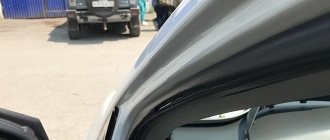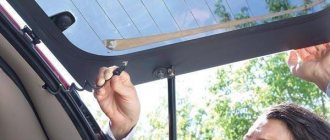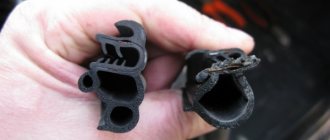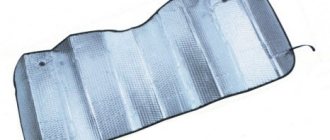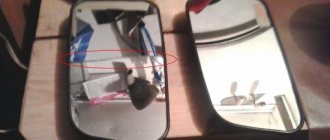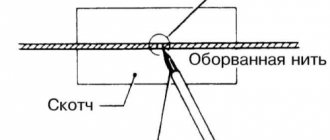How can I remove tinting glue from glass?
The tint material leaves marks that are quite difficult to remove if the film is removed incorrectly.
However, this problem can be dealt with using both professional chemical compounds and home remedies. It is important to observe safety precautions, follow the instructions for use and handle glass carefully. You can wipe off the glue from the tint with anything - there is a wide choice of professional and folk remedies, but the success of the manipulations directly depends on the actions taken to remove the film. The more carefully the tint layer is removed, the less adhesive composition will be observed on the surface. Tint removal options:
- One sharp movement. You should pick up the edge of the covering, grab it with both hands and pull it down with a sharp movement. Sticky particles will remain on the surface.
- Slow removal. To soften the glue, it is necessary to heat the tinted surface using a hairdryer to a temperature not exceeding 60 °C. Then you need to pry off the tint material with a knife or other sharp object and gradually remove the film, periodically heating the places where it comes into contact with the glass. After using this method, very few adhesive particles will remain.
- Soapy solution. You should mix a little liquid soap or soap shavings with water until a homogeneous solution is formed, separate the edge of the film with a knife and apply the mixture to the junction of the tinting with the glass. The material must be removed very slowly, otherwise the glue will not move away from the plane.
- Ammonia solution. Ammonia should be applied to the tint, then cover the treated area with cling film. After several hours, the material can be easily removed along with the glue, and the remaining particles of the adhesive composition can be wiped off with a regular soap solution.
Useful tips on how not to damage car parts during manipulations:
- the glass should be heated with a hairdryer no more than 40–60 °C, otherwise it will crack, and the film and plastic used to decorate the interior may melt;
- To make it easier to remove the film from the side windows, you need to lower the glass halfway;
- cleaning the rear window should be carried out with extreme caution to prevent damage to the heating filaments;
- working with chemicals (especially highly toxic ones) requires the use of a respirator, gloves and a protective suit;
- Under no circumstances should the vehicle be left with adhesive residues on it, as it collects dust and dirt, interferes with the driver's view and may interfere with the operation of the power windows.
Before removing glue from glass after tinting, you must choose the right proven product. You should not experiment with your own car and test various techniques, since such carelessness threatens damage to expensive and difficult-to-install elements.
The most popular methods that have shown high efficiency:
- mechanical impact;
- treatment with soap solution;
- use of oil-containing substances (gasoline, acetone);
- applying compounds to remove tinting from car windows.
Special chemicals:
- biosolvents;
- universal household cleaners;
- glue cleaners.
More on the topic Checking the PTS: how to punch a car using the PTS number in the traffic police
Before removing the adhesive mechanically, you need to prepare a solution based on water, liquid soap or wood shavings. The best effect will be achieved if you add ammonia (3-4 drops) to the mixture. The dried adhesive composition is heated with a hair dryer, soap foam is splashed onto the surface to be cleaned. Then the glue is rubbed off with a special scraper without pressing the device too hard to avoid scratches. If all sticky particles have been removed, it is worth degreasing the glass with alcohol or solvent.
Shavings of laundry soap mixed with water or an aqueous solution of dishwashing detergent can also remove traces of glue on glass. It is necessary to apply the liquid to the surface to be cleaned and wait until it dries, then repeat the procedure again. The adhesive composition can be easily removed with a soft cloth or sponge, after which you should wipe the glass with a dry cloth.
Solvents containing petroleum easily remove sticky traces of tinting. It is necessary to wipe the entire surface with the selected product, wait about 10 minutes and easily remove the soft glue with a sponge or cloth.
Many stores sell special compounds for removing tinting. It is enough to apply them to the surface, wait the time specified in the instructions, remove the adhesive particles and wipe the glass dry. The disadvantage of this method is the high cost of professional compositions.
Other products that have shown high effectiveness:
- the rust converter is applied to the sticky glass for 10–15 minutes, after which the glue can be easily washed off;
- “Anti-Glue Moment”, which recently appeared on the modern market, destroys various types of sticky bases; its convenient gel-like consistency makes it easy to clean vertical surfaces;
- "Citosol" is an absolutely non-toxic biosolvent that copes with vinyl and bitumen in the adhesive material;
- anti-corrosion compounds or water-repellent sprays are used in a similar way to solvents and can easily cope with sticky glue stains on glass;
- liquid for cleaning headlights and body parts from bugs (you shouldn’t skimp on such a product, it’s better to choose a high-quality and effective one).
Sometimes motorists resort to unusual cleaning methods. The most commonly used is Cola Cola. Glass with glue residues should be wiped with a soft cloth or sponge dipped in soda.
How to remove stickers and glue using improvised methods
You can remove stickers from glass using substances available in any home. The list of the most effective ones includes vegetable oil, ammonia, acetone and other available means.
Vegetable oil
To remove sticker glue from glass, you will need cotton pads, a dry sponge and vegetable oil.
Moreover, it does not matter which product will act as a cleaner. Regular sunflower, olive, linseed and other types of oils are suitable.
Step-by-step instruction:
- Peel off the top (vinyl) paper layer from the sticker.
- Soak a cotton swab or small rag in vegetable oil.
- Place it on the dirty area for a couple of minutes.
- Remove the remaining adhesive layer with the soft side of the sponge.
- Clean the surface with glass cleaning spray.
If after applying the oil there are still streaks on the sticker, soak the remaining glue with acetone or white spirit. Lightly heat stains soaked in solvent with a hairdryer. The remaining glue will begin to roll into lumps, which can be removed from the glass with a rubber spatula or eraser.
Ammonia
Ammonia will help remove stickers from plastic windows.
Even grandmothers used the substance to wash glass and crystal by diluting it in water. To clean the glue, prepare another mixture - ammonia + dish soap (proportions 3:1).
Step-by-step instruction:
- Open a window for ventilation (ammonia has a pungent odor that can cause burns to the mucous membrane).
- Mix ammonia and dishwashing detergent. Lightly foam the resulting liquid and soak a sponge in it.
- Apply the sponge to the remaining sticker. Fix for half an hour.
- Remove any remaining glue with a plastic scraper or the rough side of a sponge.
After removing the sticker, wash the windows with an aqueous solution of ammonia. It will remove adhesive residues and create a protective film on the glass, which will protect the surface from dirt settling for several months.
It is better not to use the substance for cleaning glasses and dishes. Even when diluted with water, it emits a pungent odor that is difficult to get rid of.
Acetone
The substance quickly dissolves adhesive fractions and fats.
However, it is only effective against fresh stains. For processing you will need acetone and a couple of cotton pads.
Step-by-step instruction:
- Soak a cotton swab in acetone.
- Rub the sticker or its mark.
- Press the cotton wool so that it sticks to the glass.
- Leave for 15–20 minutes.
- Remove any remaining dirt.
- Repeat treatment if necessary.
Acetone has many analogues (solvent, white spirit, nail polish remover, gasoline, kerosene). Any of them is suitable for removing stickers from glass.
Dishwashing liquid
Liquid soap or dishwashing detergent will help remove the sticker from the glass.
In addition, you will need a sponge and an old toothbrush.
Step-by-step instruction:
- Pour 1 tbsp into ½ glass of water. l. dishwashing liquid and lather the mixture.
- Soak a sponge in the foam and apply it to the sticker.
- When the paper softens, pry it with your finger and carefully peel it off.
- Reapply foam to the remaining adhesive on the glass.
- Damage glass with a toothbrush.
Wetting and rubbing will have to be repeated several times until the sticker mark completely disappears.
What else can you clean?
There are other ways to remove glue from a sticker. Some types of dirt remaining from stickers can be removed with a regular sponge dipped in water. But there are other proven life hacks:
Scotch. If the sticker has not been on the glass for long, adhesive tape will help remove it. It is enough to stick it on the removable paper layer and slowly peel it off the surface. After removing the stickers, the glass is degreased with acetone to remove any remaining glue that is not visible to the eye.
Vodka (alcohol, cologne, perfume). Test the substance in an inconspicuous area (high concentrations of ethanol can deform glass). Moisten a cloth with alcohol and rub the sticky spot with it.
Citrus zest. Fruit peels contain special acids that dissolve sticky substances. To remove the sticker, rub it with orange zest until the juice appears.
Vinegar. The acid contained in 9% liquid dissolves the glue. She is able to remove old stains. Apply a little vinegar to the sticker and leave for 5 minutes. Softened paper can be easily removed with a sponge. Remains of the sticker are scraped off the glass with a plastic card or a soft brush.
Available methods can affect the condition of the glass in different ways (cause its deformation, loss of color and shape). The hardest part is when cleaning glassware, when aggressive substances often cause the product to lose its presentation. Therefore, before using home windshield wipers, it is better to first test them in an inconspicuous area.
Methods for removing adhesive
It is impossible to clean the heated rear window of a car using a scraper or blade. The heating filaments can be damaged, so it is better to use other methods.
When removing film from the rear window, proceed in the following order:
- Remove all seals from the window. This will provide free access to the edges of the tint film.
- Wet the glass with the prepared solution, paying special attention to the top part of the tint. The solution should penetrate under it.
- Separate the coating from the glass and carefully pull it down with both hands. Wipe off any remaining glue immediately.
Removing the adhesive from the rear window is much more difficult than removing the tinting adhesive from the glass on the side doors. It is important to always remember the existence of heating filaments. Do not rub the surface with sharp or hard objects; it is better to use a soft cloth or napkin.
The rear window should not be treated with cleaners or other aggressive chemicals. Scratches and abrasions that will certainly appear after using such compounds will spoil the aesthetically attractive appearance of the car.
More on the topic Auto loan terms for used cars
The choice of method for cleaning a car from adhesive after removing tint depends on the area of contamination, the type of adhesive and other factors. Through trial and error, you can find a product that will help erase traces of the removal of the tint material. To avoid damage to interior and body elements, it is important to remember the features of cleaning the rear window and other nuances.
You can wipe off the adhesive residue in different ways. However, not all of them are safe. The most popular methods for cleaning car glass from glue after removing tinting are:
- Cutting is done using sharp tools. Before work, moisten the glass with soapy water. This method is the most effective, but requires a lot of time and patience, especially if the glass is heated. After cleaning, the surfaces must be wiped with alcohol or another degreaser.
- Wipe the glass with a cloth previously soaked in any solvent. After a few minutes, the glue is cleaned off with a squeegee. When using this method, you must adhere to fire safety rules, and then you need to get rid of the smell in the car interior.
- To clean the glass from glue after tinting, use special liquids in the form of a spray. The substance is applied to the surface and wait for the time indicated on the package. To remove glue from glass tint, use a special spatula, which is sold with the bottle. The disadvantages of such products include high price and toxicity.
- You can remove glue from glass after tinting using a thick soap solution and a sponge. Any dishwashing detergent available in the house is diluted in water until a rich foam forms. Apply the solution to the contaminated surface with a sponge. It is allowed to dry and then applied again. Dried glue can be easily cleaned off with a soft abrasive - the other side of the sponge. The cleaned surface must be wiped dry.
- They use a special rust converter, Star Wax - spray it onto the surface, wait about 10 minutes and wipe it with a rag.
- Profoam 2000, WD-40 or anti-rain cleaner is applied to the glass and then removed with a rag or squeegee, which can be replaced with a plastic card.
- Supermoment Antiglue removes glue from any vertical surfaces.
- Cytosol removes the adhesive layer from bitumen or polymer components.
- Coca-Cola Lemonade copes with many types of glue no worse than expensive special products.
How to remove tint correctly (for the future)
To leave a minimum of glue from the film, you need to know how to properly peel off the tint from the glass. To carry out dismantling you need to prepare:
- Construction hair dryer;
- Stationery knife.
The procedure is performed as follows:
- Using a utility knife, pry up a corner of the tint film so that you can pick it up with your fingers.
- Heat the hairdryer to 300-400°C.
- Pre-warm the work site.
- Start pulling the film with gentle force. The heated glue liquefies and lags behind the glass.
- Cut off large pieces of the removed film with a utility knife, this will simplify the process.
You can easily wipe off the glue after removing the tint film if you choose the right method. To avoid damaging the glass, you need to use only proven methods and means . You can simplify the procedure and minimize the amount of glue residue by properly dismantling the tint film.
Nowadays, many drivers drive with tinted car windows. But there are times when you have to get rid of the tint. When you clean it from the glass, glue remains on it, which is difficult to get rid of.
In this article we will tell you how to remove tinting glue from glass yourself and how to remove the film.
Composition of tinting adhesive
After removing the tint, sticky spots remain - part of the adhesive coating used in production. Tinting is a special self-adhesive film. The bottom layer contains special adhesive compounds that, when in contact with the surface, form a strong adhesion.
Various adhesives are used in the production of tinting: CD, PS, CDF, DPS, PS/DT. Considering so many of them, it is quite difficult to answer the question of how to remove glue from glass after tinting. Each case is individual and requires the use of different removal methods.
What to scrub with?
You can try to remove the glue mechanically by scraping it off the surface of the glass with a sharp object. This method is effective, but it cannot be called safe. As a result of friction, microcracks and chips will appear on the glass, which cannot be hidden.
More on the topic: Varnish for tinting headlights
Therefore, it is better to use solvents to remove tinting glue. They will help you quickly and safely remove sticky marks from the glass surface.
Soap solution
Soap solution is the most accessible and cheapest means for removing glue, which will not damage the glass, does not have a strong odor, and does not contain caustic substances.
To prepare it you will need:
- 1 liter of warm water.
- 40 g of soap, ground into shavings.
- ½ teaspoon of ammonia.
All components are mixed and poured into a spray bottle. Apply the solution as follows:
- The film is carefully lifted with a sharp object and slightly pulled towards you.
- Spray a soap solution into the resulting opening, continuing to carefully remove the tint.
- Remains of glue are removed with a rag.
- The procedure should last until the film completely comes away from the glass.
- The surface is sprayed with the solution again, and the remaining tint is removed with a clean napkin.
If the film was removed a long time ago and the glue has dried, pre-soaking will be required. In this case, the recipe needs to be slightly improved by adding 5 drops of glycerin to the soap so that the liquid does not harden. Using a spray bottle, apply the solution to the glass, leave for 15-30 minutes, after which you begin cleaning.
When you need to quickly remove dried glue, use a hair dryer. It is used to heat dried stains, which are treated with a warm soapy solution and washed with a rag.
Recommendations
Tips for quickly and effectively removing traces of glue from tinting:
- You need to start cleaning immediately after removing the tint.
- The longer the tint was on the glass, the stronger the glue will adhere to it. For difficult cases, choose products with an aggressive composition.
- When working with any solvents, you need to take care of personal protective equipment in the form of gloves and a mask.
- After finishing cleaning, the glass must be washed and wiped dry. This will allow you to identify untreated areas and, if necessary, repeat the procedure.
When choosing a glue remover, you should always pay attention to its composition and the manufacturer’s recommendations. There are substances that cannot be used on glass surfaces.
You will find a lot of useful information about ways to remove glue from glass in this section.
Questions and answers
How to remove glue from heated glass?
Heating tracks can be damaged, so many are afraid to remove the glue themselves. However, there is nothing complicated about it. You can use the formic alcohol method or purchase special products. If the glue is old and hard, the chosen product needs to be left on a little longer. Remove any remaining glue with a rag or napkin.
How to remove tint along with glue?
The best way to get rid of glue on your car window is to remove it along with the tint. To do this, the film is doused with steam from a steamer (you can use it from the spout of a boiling kettle). After a few seconds, the film begins to come off easily. You can also heat the glass with a hairdryer, but this should only be done from the outside, otherwise the film may stick. In order not to damage the heating tracks, the tint is removed diagonally (obliquely).
In conclusion, if the tint is relatively new and of good quality, removing the remaining adhesive from the glass will not be difficult. A solid adhesive composition will require preliminary softening or dissolution. It is important to take into account the temperature in the room: the higher it is, the more effective the methods described above work.
Self-removal of coating
Before you start removing the tint, you need to know how to remove it so that as few sticky spots as possible remain on the surface. There is a special way by which you can remove the film as cleanly as possible. Its surface is heated to 50° with a hair dryer and slowly pulled together.
You can remove tint yourself in the following ways:
- with a quick jerk, during which the entire film is removed;
- heating with slow peeling;
- gradual removal of the coating.
If independent intervention does not give the desired result, you should use another glass cleaning product or contact a professional.



